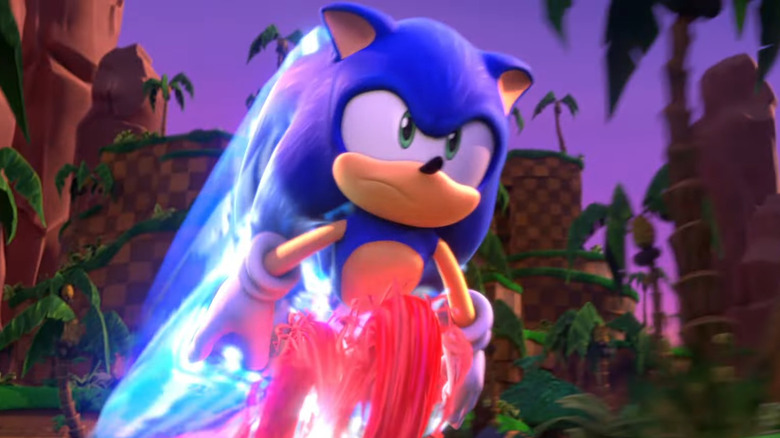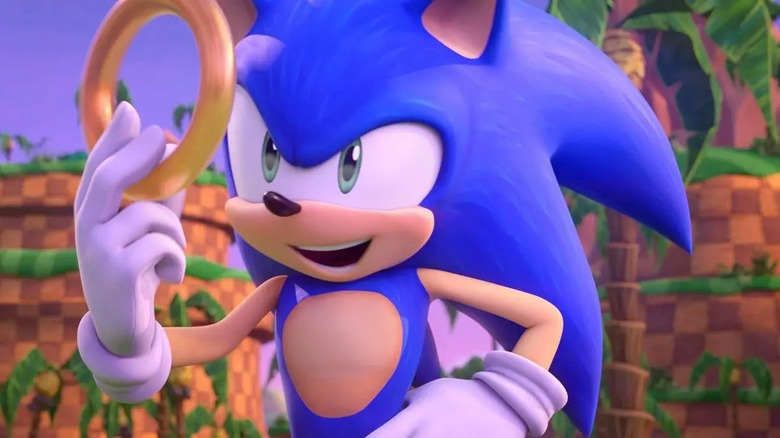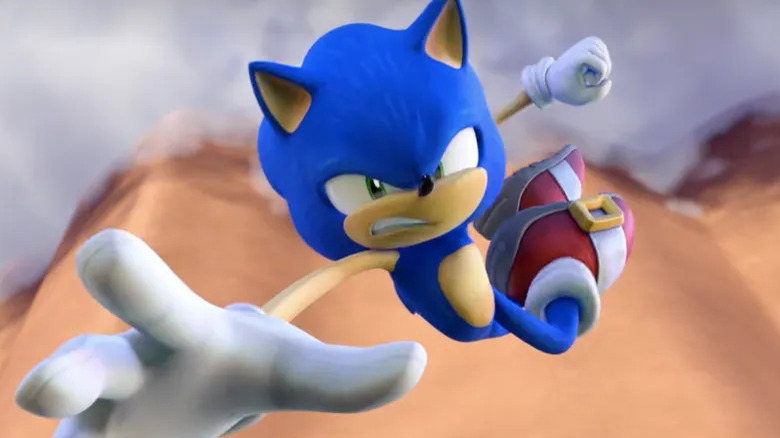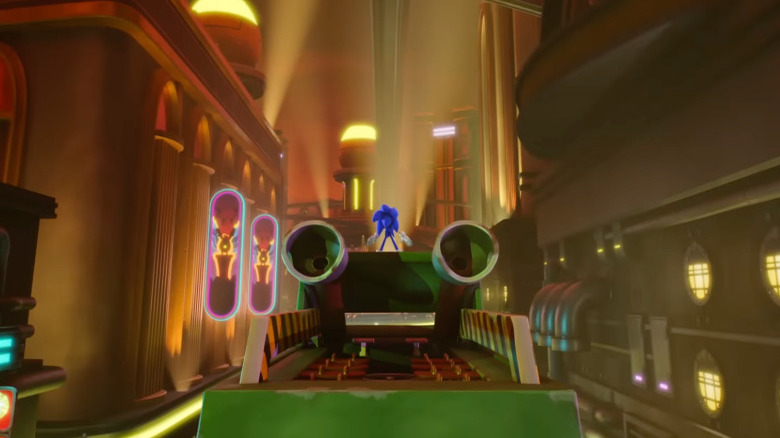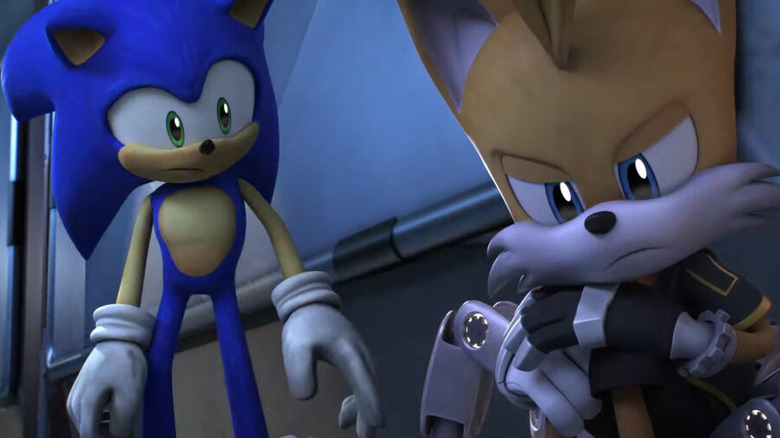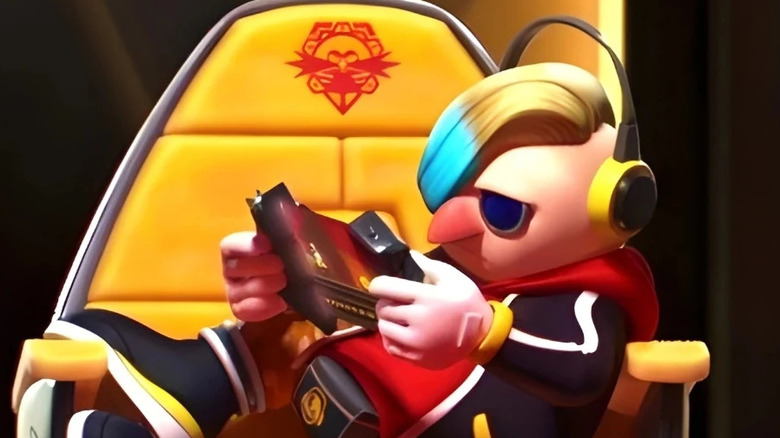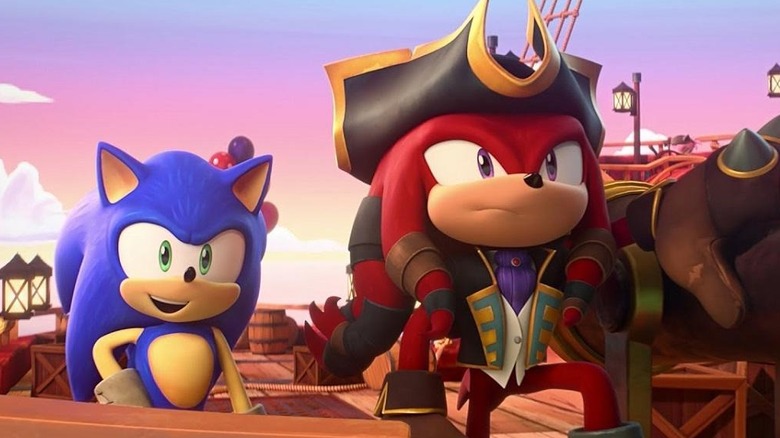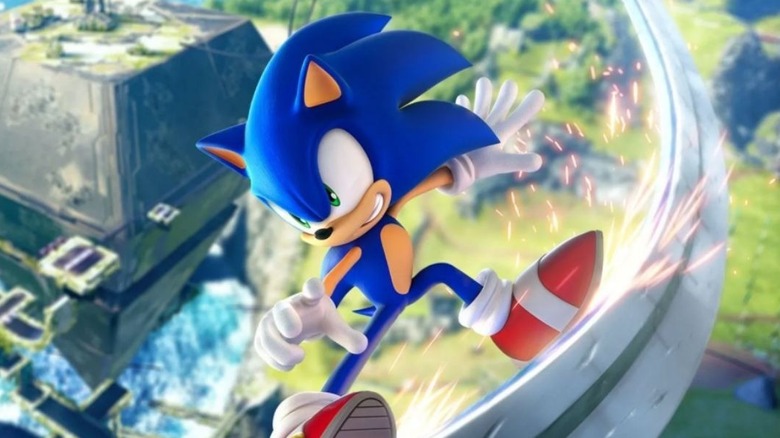Easter Eggs You Missed In Netflix's Sonic Prime
Sonic the Hedgehog is no stranger to adaptation. The character was created by Japanese video game company Sega in 1991 as their flagship mascot to rival Nintendo's Mario. Since then, the character has undergone many interpretations, from racing spin-off video games to Hollywood movie adaptations. Most recently, comedian Ben Schwartz began voicing the character in a movie series alongside Jim Carrey as Doctor Robotnik and James Marsden as a well-meaning sheriff who befriends the character.
However, Netflix is the home of the Blue Blur's latest adaptation — an animated series titled "Sonic Prime." The series finds Sonic traversing the multiverse after a battle with Dr. Eggman goes wrong. In the first eight episodes released on Netflix in December of 2022, Sonic interacts with several alternate versions of his closest friends — such as Tails, Amy, and Knuckles — while facing versions of Dr. Eggman who prove to be way more threatening than the Eggman he's used to.
Unlike the feature films that bring Sonic's anthropomorphic world to real-life Earth, this series is grounded firmly in the familiar locales of "Sonic" video games. "Sonic Prime" could be the most loyal adaptation of the character in outside media to date and features many Easter eggs and references to Sonic's video game origins. Although some of these Easter eggs will be easily spotted by most loyal fans of the "Sonic" franchise, other viewers may be surprised by what they missed.
Welcome to Green Hill Zone
It doesn't take a hardcore fan of "Sonic the Hedgehog" to see the attention to detail in the very first moments of "Sonic Prime." Even its earliest trailers show off a look at Green Hill Zone, the iconic setting featured in many "Sonic the Hedgehog" games. The locale serves as the first level in 1991's original "Sonic the Hedgehog" game on Sega Genesis, featuring robotic palm trees, checkered ground, and loop-de-loops. The California-inspired aesthetic has been a mainstay of the franchise ever since, reappearing in games like "Sonic Generations" and "Sonic Frontiers" (via Lego).
Its appearance in "Sonic Prime," however, takes on a more realistic approach, featuring more rounded edges than right angles. Nevertheless, it looks vibrant and beautiful in HD, which will certainly satisfy longtime fans of the franchise. Furthermore, Green Hill Zone's iconic elements later prove to be important in Sonic's journeys through alternate universes.
In the first episode of "Sonic Prime," Sonic ends up unknowingly transported to New Yoke City — a dystopia ruled by Dr. Eggman and his cohort. However, it's Sonic's realization that New Yoke City is built on the foundation of Green Hill Zone that truly subverts his expectations. His view of Green Hill Zone's iconic loop-de-loop remains untouched by the city, acting as an in-universe Easter egg for the way Green Hill Zone used to be.
The importance of collecting rings
Another early Easter egg in "Sonic Prime" comes when Sonic zooms through Green Hill Zone collecting rings. Even down to the sound effects, this should be a familiar sight for many "Sonic the Hedgehog" fans, as it's the central mechanic of many games in the series. Oftentimes, the goal of "Sonic" games is to speed through levels as quickly as possible while simultaneously collecting as many rings as possible. However, that's not the only use rings have — they also serve as Sonic's health, spilling out of him when he gets hit.
"Sonic" adaptations tend to put different spins on the purpose of collecting rings. In the feature film franchise, rings are portals between different dimensions, which explains how Ben Schwartz's Sonic travels from his native home of Green Hill Zone to Earth. In "Sonic Prime," fans of the franchise will notice that rings retain their original purpose from the games, as Sonic ends up late to a battle with Eggman because he takes a minute on the way to collect rings, which protect him from harm.
The absence of Sonic's rings in New Yoke City is also mentioned in the first episode. Cornered by Dr. Eggman's surveillance robots, Sonic remarks that all of his rings have disappeared, leaving him susceptible. This lines up with their use in the original Sega Genesis games, where Sonic's lack of rings would result in him losing a life, and possibly the game, after getting hit.
Codes refer to significant Sonic dates
As with any adaptation of an existing IP, numbers are a very obvious way to insert Easter eggs. This is true of "Sonic Prime," which has several noticeable number-related Easter eggs in its first episode. The first comes during a flashback sequence when Sonic visits Tails in his laboratory following a confrontation with Dr. Eggman. The code Sonic uses to enter is "1992," which is the same year that Tails made his debut in the video game "Sonic the Hedgehog 2."
Although the focus on Sonic entering the code works as a simple Easter egg referencing Tails' first appearance, it also remains an important setup for later. When Sonic follows an alternate version of Tails in New Yoke City, he uses the same "1992" code to enter Tails' secret underground lab.
Another number-related Easter egg comes a bit earlier, when Sonic first arrives in New Yoke City. He quickly meets Big the Cat, a recurring "Sonic the Hedgehog" character who debuts in "Sonic Adventure" as a playable character in search of his best friend Froggy who appears alongside Big in an early scene in the "Sonic Prime" pilot. As Sonic tries to interact with the alternate Big the Cat, surveillance robots address Sonic's old friend as "Citizen 1998." As you might expect, 1998 was the year "Sonic Adventure" was released on Sega Dreamcast, making this Easter egg similar to Tails' lab code.
Sonic's signature moves
Of course, it wouldn't be a "Sonic"-inspired animated series if fans didn't get to see Sonic busting some robot butt. The show definitely doesn't skimp on action, starting off with some pretty high-stakes combat between Sonic and Dr. Eggman's robots over a rock known as the Paradox Prism. This is the show's first glimpse of Sonic's fighting style which, luckily for fans of the franchise, is pretty reminiscent of his in-games moves.
Sonic's abilities throughout the series include two of his most frequent methods of attack in the games — his homing attack and his spin dash. According to Logan McPherson of WildBrain Studios, including the classic attacks of Sonic and his supporting cast was essential to the passion behind the project (via GameInformer).
The spin dash, for instance, is one of Sonic's most iconic moves; he curls up into a blue ball and rams into robotic enemies, crushing them without even flinching. The homing attack is Sonic's other well-known move, which finds him hovering in mid-air then directing himself down towards one or more enemies. In the games, this allows Sonic to string together combos, which he also does in "Sonic Prime." Aside from Sonic's familiar moves, he also has plenty of new ways to attack in "Sonic Prime," including kick flips and mid-air ground pounds.
Entering a dystopian alternate reality
As the introduction to Sonic's adventures in the multiverse, the first episode of "Sonic Prime" places the hedgehog in the dystopian metropolis of New Yoke City. Here, Dr. Eggman rules with his Chaos Council as the city's nameless citizens travel with dour expressions. While it's certainly a culture clash for the "Sonic Prime" version of Sonic, this premise is not unfamiliar to most "Sonic the Hedgehog" franchise fanatics.
Specifically, this exact premise has appeared in both the 1993 animated series "Sonic the Hedgehog" and the Archie Comics series of the same name. The first episode of the 1993 series, "Sonic Boom," centers on the titular character taking on Dr. Robotnik's city Robotropolis, originally the thriving city of Mobotropolis. Since "Sonic Prime" featured consultation work by Archie Comics writer Ian Flynn, it's no wonder Sonic is treading on familiar territory here.
Additionally, the video game series has also features similar premises. The infamous 2006 title "Sonic the Hedgehog" centers on Sonic's battles against forces of a post-apocalyptic dystopian future. The 2017 game "Sonic Forces" also features a similar premise; a world left without Sonic to defend it results in the formation of a rebel movement led by Knuckles and Rouge the Bat. While this storyline in "Sonic Prime" may be familiar to those who have played many different "Sonic" games, some fans will be surprised by its new take on classic "Sonic" characters like Tails.
An alternate Tails backstory
When Sonic finally finds Tails hiding in a secret lab underneath New Yoke City, he's greeted by a very different version of his best friend. Going by the name "Nine," this Tails is a hardened cynic who fights with robotic tails and uses them to battle an apprehensive Sonic. Soon enough, Sonic convinces Tails he's telling the truth after saving him from an oncoming train, prompting a meaningful moment between them.
Sonic explains how he met the Tails from his world, which leads to a flashback sequence stylized in 16-bit pixel art reminiscent of Sonic's Sega Genesis days. Even the Green Hill Zone setting makes this moment a nostalgia trip for diehard "Sonic the Hedgehog 2" fans, though Nine's memory of the incident is slightly different. In a pixel-art version of New Yoke City, Nine recounts how the bullies that Sonic remembers fighting off only made his life worse, alerting audiences to Sonic's absence from this alternate timeline.
This was a meaningful moment for the show's creators, too. As Logan McPherson put it, adding the 16-bit flashbacks was their attempt to be faithful to the original "Sonic the Hedgehog" game, hoping viewers would be excited about it (via Animation Scoop). However, some fans online had a poor reception to the pixel art graphics in "Sonic Prime," namely their inaccuracy to the original games. Although it may not satisfy all classic "Sonic the Hedgehog" fans, it's a well-executed Easter egg referencing Sonic's video game origins.
Dr. Don't gets a game over
The introduction of New Yoke City's Chaos Council is one of the biggest twists in the first episode of "Sonic Prime." While the hedgehog is expecting this city to be ruled by Dr. Eggman, he certainly isn't expecting four additional faces: the infant Dr. Babble, the elderly Dr. Done It, the hippie Dr. Deep, and the teenage Dr. Don't. Video game fans will immediately clock Dr. Don't's preoccupation with playing video games himself, as he lazily reclines with a futuristic Nintendo Switch-style console.
However, Episode 2 gives audiences a closer look at Dr. Don't's game, which harkens back to the 16-bit graphics of Sonic's Sega Genesis days, just like the pixel art flashbacks. In this game, Dr. Don't plays as himself riding an Eggmobile just like Dr. Eggman in the original games. Some fans noted that this particular Eggmobile in Dr. Don't's game is more akin to the Egg Drillster from "Sonic the Hedgehog 2," the first game to introduce Tails.
That's not the only Easter egg involving Dr. Don't in "Sonic Prime." At one point in the second episode, Dr. Don't gets a game over screen depicting his pixel incarnation wiped out underneath a spotlight. This is a clear reference to the game over screens from the original games which show Sonic in a similar situation. The "Sonic" franchise referenced this same screen years earlier in "Sonic Generations."
Sonic retains his love for chili dogs
"Sonic Prime" carries on one of the most iconic aspects of Sonic the Hedgehog — his love for chili dogs. The meaty delicacy is essentially Sonic's equivalent to Scooby Snacks or Popeye's spinach. According to an article from Inverse about the history of Sonic's chili dog love affair, it originated in the story bible for the "Sonic" media enterprise in 1992. Apparently, Sonic's insatiable hunger for chili dogs stems from his unseen Uncle Chuck.
The chili dogs recur often in Sonic's Archie Comics appearances, as well as the two concurrent animated series – "The Adventures of Sonic the Hedgehog" and "Sonic the Hedgehog — where Jaleel White of "Family Matters" fame voiced the character in both shows. Sonic's love for chili dogs was rarely mentioned in his video game appearances until "Sonic Unleashed," later making appearances in cutscenes for games like "Sonic and the Black Knight" and "Sonic Generations."
In "Sonic Prime," the hedgehog remains an avid fan of chili dogs, though he's confronted with an alternative during his adventures with a crew of pirates in an alternate universe. Sea dogs replace Sonic's preferred chili with relish, which becomes an important factor, as the sea dogs' relish proves vital to defeating an evil Amy variant known as Rusty Rose. Suffice it to say, the snack easily wins Sonic's heart.
Sonic has had a middle name since the '90s
One of the most revealing Easter eggs in "Sonic Prime" isn't even in the show itself; it can be found in the show's official description on Netflix, which many viewers of "Sonic Prime" might barely even notice. It certainly caused quite a stir among "Sonic" fans as it refers to Sonic's little-known middle name: Maurice. While this may seem like a random detail, it's a callback to some pretty deep "Sonic the Hedgehog" lore.
That lore harkens back to Sonic's Archie Comics appearances, which flesh out his backstory much more than the mainline games ever have. Sonic's middle name is referenced throughout Sonic's Archie Comics 1992 miniseries, starting from the very first issue, and is eventually discovered by Knuckles, though Sonic shuts down the near reveal of his real first name.
Sonic's first name has yet to be revealed by any official source, though fan speculation has suggested that it may be "Ogilvie" which, in theory, would make the Blue Blur's full name Ogilvie Maurice the Hedgehog (via ScreenRant). With a name like that, it's understandable why he prefers to just be called Sonic, but perhaps the official description for "Sonic Prime" is a clue for eagle-eyed fans that this embarrassing name is actually canon in the series.
The return of Sonic's aquatic fear
Episode 7 of "Sonic Prime" finds Sonic encountering alternate versions of his friends led by Knuckles the Dread on the pirate ship Angel's Voyage as he searches for more Prism Shards. As the pirate crew nears an undersea threat, Sonic loudly hopes it's not an orca. Though this seems like a throwaway line, it's a pretty deep cut reference that many hardcore "Sonic the Hedgehog" fans will understand.
Sonic has crossed paths with orcas before, particularly in the Sega Dreamcast title "Sonic Adventure." Released in 1998, "Sonic Adventure" is often considered by critics one of the best "Sonic" games, as well as one of the best Dreamcast launch titles according to Eurogamer. One of the most iconic moments in Sonic's storied history comes during an early level in "Sonic Adventure," where Sonic is chased by an orca.
Orcas have reappeared elsewhere in the "Sonic" games. In "Sonic '06," Sonic rides an orca during one level, while "Sonic Generations" features a scene that recreates Sonic's killer whale encounter in "Sonic Adventure." Although many "Sonic" fans have speculated about Sonic's deal with orcas, "Sonic Prime" seems to imply that Sonic fears of the aquatic creature.
An ongoing rivalry with Shadow
Shadow the Hedgehog's inclusion in "Sonic Prime" was no easy feat for the show's creators. According to Logan McPherson, Sega placed a lot of restrictions on the show's writers pertaining to Shadow's portrayal. As a result, the character's appearance in the show at all was a real labor of love by the creators to make him faithful to his game appearances. Hopefully, "Sonic the Hedgehog" franchise fans will be very satisfied by his role in the story.
Shadow made his first appearance in "Sonic Adventure 2" as the ultimate life form created to rival Sonic. Although the two end up joining forces against Dr. Eggman, they remain on opposite sides during many future games, mostly as a result of Shadow having his memory wiped. Shadow even stars in his own game, "Shadow the Hedgehog" which, like his appearance in "Sonic Prime," is much more mature and serious than many other "Sonic the Hedgehog" titles.
Since only eight out of 24 episodes of "Sonic Prime" have been released by Netflix so far, there's a lot that's yet to be revealed about Shadow's involvement in the story. So far, he's shown up to antagonize Sonic for his failure to stop Dr. Eggman from creating these alternate universes, giving them plenty of opportunities to spar. Hopefully, fans will get to see more Sonic and Shadow interactions in future episodes.
Artifacts of the Ancients from Sonic Frontiers
Some eagle-eyed "Sonic the Hedgehog" fans were able to spot many Easter eggs throughout the first eight episodes of "Sonic Prime." One of the hardest Easter eggs to spot isn't just easy to miss due to its obscurity in the show, but because of what it references – "Sonic Frontiers," the most recent "Sonic the Hedgehog" game, released in late 2022 shortly before the premiere of "Sonic Prime."
In Episode 7, "It Takes One to No Place," Knuckles the Dread tells Sonic about his former crew's attempt to hunt a treasure known as the Devil's Lighthouse. During the flashback sequence, fans can spot the same type of puzzle statue that appears in "Sonic Frontiers." It can be easy to miss in the background as Knuckles recounts his ship crashing, but there are plenty of opportunities to see it between Episodes 7 and 8.
Given their inclusion in "Sonic Prime," it's possible the remaining episodes of the Netflix series will consist of even more Easter eggs for the newest mainline "Sonic the Hedgehog" title. Although some fans may view these Easter eggs as simple marketing schemes or fan service, they enrich a series that has a lot of heart and consideration for the most passionate "Sonic" followers.

